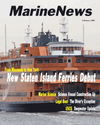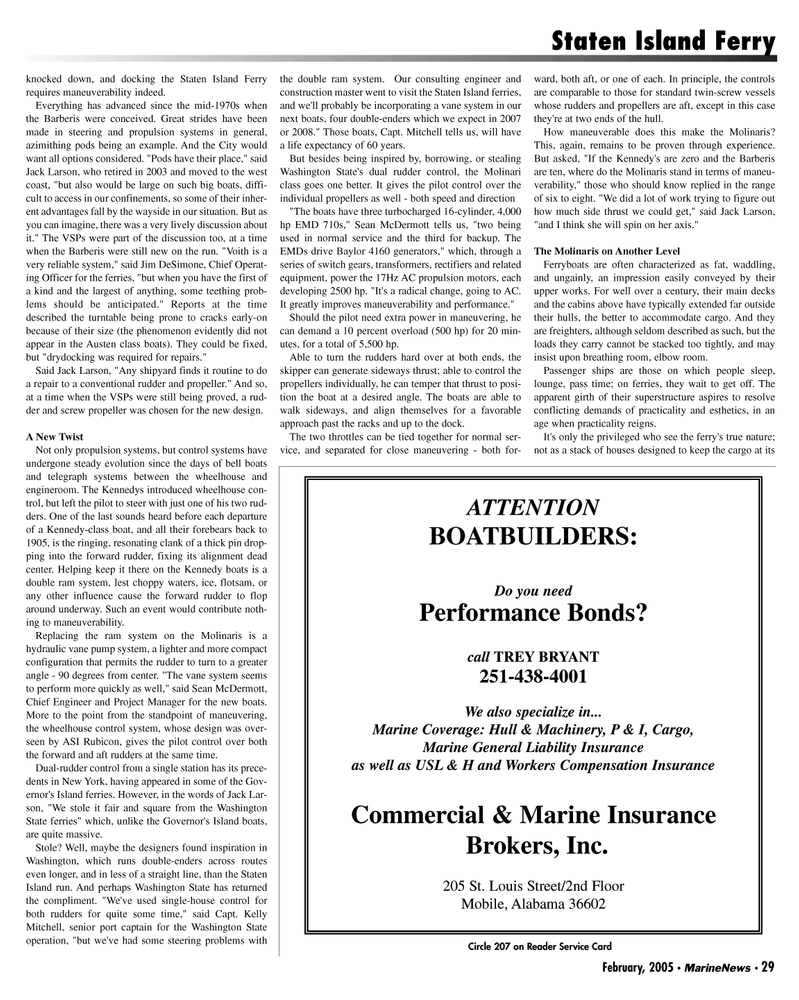
Page 29: of Marine News Magazine (February 2005)
Read this page in Pdf, Flash or Html5 edition of February 2005 Marine News Magazine
knocked down, and docking the Staten Island Ferry requires maneuverability indeed.
Everything has advanced since the mid-1970s when the Barberis were conceived. Great strides have been made in steering and propulsion systems in general, azimithing pods being an example. And the City would want all options considered. "Pods have their place," said
Jack Larson, who retired in 2003 and moved to the west coast, "but also would be large on such big boats, diffi- cult to access in our confinements, so some of their inher- ent advantages fall by the wayside in our situation. But as you can imagine, there was a very lively discussion about it." The VSPs were part of the discussion too, at a time when the Barberis were still new on the run. "Voith is a very reliable system," said Jim DeSimone, Chief Operat- ing Officer for the ferries, "but when you have the first of a kind and the largest of anything, some teething prob- lems should be anticipated." Reports at the time described the turntable being prone to cracks early-on because of their size (the phenomenon evidently did not appear in the Austen class boats). They could be fixed, but "drydocking was required for repairs."
Said Jack Larson, "Any shipyard finds it routine to do a repair to a conventional rudder and propeller." And so, at a time when the VSPs were still being proved, a rud- der and screw propeller was chosen for the new design.
A New Twist
Not only propulsion systems, but control systems have undergone steady evolution since the days of bell boats and telegraph systems between the wheelhouse and engineroom. The Kennedys introduced wheelhouse con- trol, but left the pilot to steer with just one of his two rud- ders. One of the last sounds heard before each departure of a Kennedy-class boat, and all their forebears back to 1905, is the ringing, resonating clank of a thick pin drop- ping into the forward rudder, fixing its alignment dead center. Helping keep it there on the Kennedy boats is a double ram system, lest choppy waters, ice, flotsam, or any other influence cause the forward rudder to flop around underway. Such an event would contribute noth- ing to maneuverability.
Replacing the ram system on the Molinaris is a hydraulic vane pump system, a lighter and more compact configuration that permits the rudder to turn to a greater angle - 90 degrees from center. "The vane system seems to perform more quickly as well," said Sean McDermott,
Chief Engineer and Project Manager for the new boats.
More to the point from the standpoint of maneuvering, the wheelhouse control system, whose design was over- seen by ASI Rubicon, gives the pilot control over both the forward and aft rudders at the same time.
Dual-rudder control from a single station has its prece- dents in New York, having appeared in some of the Gov- ernor's Island ferries. However, in the words of Jack Lar- son, "We stole it fair and square from the Washington
State ferries" which, unlike the Governor's Island boats, are quite massive.
Stole? Well, maybe the designers found inspiration in
Washington, which runs double-enders across routes even longer, and in less of a straight line, than the Staten
Island run. And perhaps Washington State has returned the compliment. "We've used single-house control for both rudders for quite some time," said Capt. Kelly
Mitchell, senior port captain for the Washington State operation, "but we've had some steering problems with the double ram system. Our consulting engineer and construction master went to visit the Staten Island ferries, and we'll probably be incorporating a vane system in our next boats, four double-enders which we expect in 2007 or 2008." Those boats, Capt. Mitchell tells us, will have a life expectancy of 60 years.
But besides being inspired by, borrowing, or stealing
Washington State's dual rudder control, the Molinari class goes one better. It gives the pilot control over the individual propellers as well - both speed and direction "The boats have three turbocharged 16-cylinder, 4,000 hp EMD 710s," Sean McDermott tells us, "two being used in normal service and the third for backup. The
EMDs drive Baylor 4160 generators," which, through a series of switch gears, transformers, rectifiers and related equipment, power the 17Hz AC propulsion motors, each developing 2500 hp. "It's a radical change, going to AC.
It greatly improves maneuverability and performance."
Should the pilot need extra power in maneuvering, he can demand a 10 percent overload (500 hp) for 20 min- utes, for a total of 5,500 hp.
Able to turn the rudders hard over at both ends, the skipper can generate sideways thrust; able to control the propellers individually, he can temper that thrust to posi- tion the boat at a desired angle. The boats are able to walk sideways, and align themselves for a favorable approach past the racks and up to the dock.
The two throttles can be tied together for normal ser- vice, and separated for close maneuvering - both for- ward, both aft, or one of each. In principle, the controls are comparable to those for standard twin-screw vessels whose rudders and propellers are aft, except in this case they're at two ends of the hull.
How maneuverable does this make the Molinaris?
This, again, remains to be proven through experience.
But asked, "If the Kennedy's are zero and the Barberis are ten, where do the Molinaris stand in terms of maneu- verability," those who should know replied in the range of six to eight. "We did a lot of work trying to figure out how much side thrust we could get," said Jack Larson, "and I think she will spin on her axis."
The Molinaris on Another Level
Ferryboats are often characterized as fat, waddling, and ungainly, an impression easily conveyed by their upper works. For well over a century, their main decks and the cabins above have typically extended far outside their hulls, the better to accommodate cargo. And they are freighters, although seldom described as such, but the loads they carry cannot be stacked too tightly, and may insist upon breathing room, elbow room.
Passenger ships are those on which people sleep, lounge, pass time; on ferries, they wait to get off. The apparent girth of their superstructure aspires to resolve conflicting demands of practicality and esthetics, in an age when practicality reigns.
It's only the privileged who see the ferry's true nature; not as a stack of houses designed to keep the cargo at its
February, 2005 • MarineNews 29
Staten Island Ferry
ATTENTION
BOATBUILDERS:
Do you need
Performance Bonds? call TREY BRYANT 251-438-4001
We also specialize in...
Marine Coverage: Hull & Machinery, P & I, Cargo,
Marine General Liability Insurance as well as USL & H and Workers Compensation Insurance
Commercial & Marine Insurance
Brokers, Inc. 205 St. Louis Street/2nd Floor
Mobile, Alabama 36602
Circle 207 on Reader Service Card
MN FEB05 (25-33).qxd 1/26/2005 5:02 PM Page 29

 28
28

 30
30
